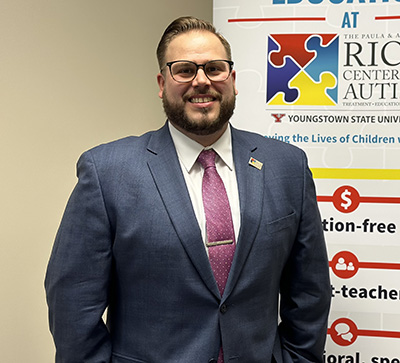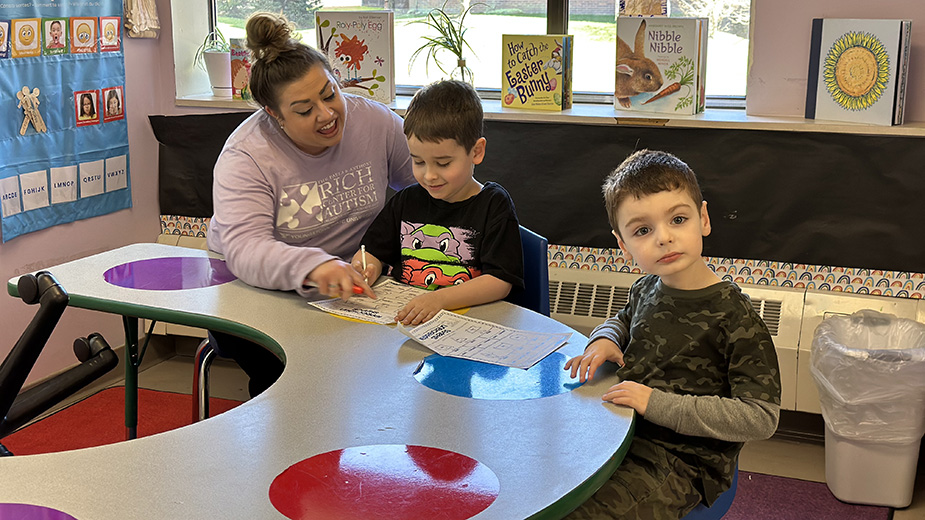YOUNGSTOWN, Ohio – Liam Johnson laughs as his teacher, Alexandra Leskovec, discusses shapes in the preschool/early childhood classroom.
On the floor above, a classroom kitchen is filled with older students learning independent living skills.
It’s all part of the services provided daily at the Rich Center for Autism at Youngstown State University.
Gregory V. Boerio, executive director of the center, says the organization is completing its 27th year in Youngstown. The education, treatment and research center serves a range of students from ages 3 to 21.

“We have students that come in right after they’re diagnosed – maybe we start to inquire around the age of 2 or 3,” he says. “We have students come in maybe after they been to a different school or different environment for a period of time. Each student’s path here is different.”
The center currently has about 60 students. In addition to the classes at YSU, the program also does work at St. Charles School in Boardman.
“The rates of autism continue to increase,” Boerio says. “The most recent stats from the [Centers for Disease Control and Prevention] suggest about one in every 44 children in the United States are diagnosed with autism spectrum disorder.”
Staying up to date and using research to determine best practices continues to be a challenge, Boerio says, but it is also exciting because changes are made daily.
Even though autism isn’t curable, early intervention is important, he says. Early intervention lets specialists discover the most effective treatment for each client as soon as possible.
Boerio says he has seen a lot of success in the programs. He says he has seen students that were primarily nonverbal before have some initial utterances, learn math computations and learn to read.
“Over the course of the school’s history, thousands of students have been part of the Rich Center for Autism,” he says. “Some have been here for short periods of time. Some have been here for long periods of time. Some have stayed local [and] some have gone to other areas.”
While the Rich Center offers a variety of services, it focuses on the specific needs of each student, Boerio says.
Services such as haircuts, dental hygiene and education are offered in coordination with community members, businesses and students, he says.
“Autism doesn’t stop at school,” Boerio says.
The Rich Center has about 30 full-time staff members in teaching and administration.
Another 15 to 20 graduate and undergraduate students from YSU are also a part of the program.
“It gives us the opportunity to train that next level of professionals,” he says. “Hopefully, a future business owner says to themself, ‘I remember my time at the Rich Center. Maybe
I’ll give that individual a chance at a job.'”
Boerio says he believes its reach as an organization far exceeds the students who are presently enrolled in the organization.
Three live research projects are currently going on at the school, he says. These include everything from robotics programs that teach social skills to learning how to code.
“No matter what we are looking at, we are helping to define best practices in autism education, which I think extends our reach here in the community,” he says.
The social skills curriculum currently uses RoboKind, a series of social-emotional assistive robots.
“We are taking a deeper dive into the implementation and structure – all those factors that may play a role in the outcomes,” Boerio says.
“Time of day, age, the amount of time they are receiving that intervention, the number of times in a particular week they are receiving that intervention – all of those individualized factors – we are conducting analysis at a high level to determine if they play a role,” he says.
The coding research project is a collaborative one, Boerio says. The organization is working with a professor at the STEM college and Potential Development.
“We are not going to be sitting around because autism doesn’t allow us to do that,” he says. “We have to stay half a step or two steps ahead of some of that latest research so we can continue to provide evidence-based instruction and supports here for our students.”
Rachael Dobson, associate director of behavior at the Rich Center, has been working at the organization since 2009. She started as a teacher and is now a board-certified behavioral analyst.
“When I first started here, the behavior department consisted of one behavioral analyst and that was an area that the Rich Center definitely needed to grow in,” she says. “We needed more help in regard to challenging behaviors that we see in the classroom.”
Today there are three behavioral analysts working at the Rich Center. They work both in and out of the classroom with students having behavioral issues.
Behavioral analysts go into the classroom to assess behaviors and come up with plans for teachers to follow. Dobson says they are also frequently in the classroom working on communication goals.
“A lot of students here need additional support in regard to communicating,” she says. “We notice that a lot of the behaviors that we are seeing are very closely related to lack of communication. If a student is not able to tell us, ‘I need a break,’ or ‘The noise is too loud,’ frustration comes from that.”
Alternative communication for nonverbal students may include pictures or iPads, Dobson says.
Students receive most instruction at the school Monday through Friday from 9 a.m. until 2:30 p.m.
Dobson says each of the classes incorporates individual instruction time, as well as a variation of a life skills class.
“We have this new life skills room upstairs where they can learn how to cook, do the dishes [and] there is a bed up there so they can practice making the bed,” she says. “We do this with all age groups.”
Dobson says the Rich Center is in the process of remodeling the building. Phase one began around 2020, and she says the life skills room was a part of that.
The Rich Center also has “gymsters” sessions once a week,where students participate in structured growth motor activities like throwing, catching, walking on a balance beam, summersaults, hopping and running.
The organization has an early childhood department, primary department, intermediate department, middle school department, high school department and St. Charles. Dobson says among the five departments at the Rich Center, there are 11 classrooms.
Boerio urges people interested in supporting Rich Center financially or in other ways to visit.
“The doors are always open,” he says. “Schedule a time and stop on by and see what we are doing in our classrooms each day. Learn more about autism.”
Pictured at top: Alexandra Leskovec teaches students Liam Johnson and Kai Wade shapes in the preschool/early childhood classroom.
